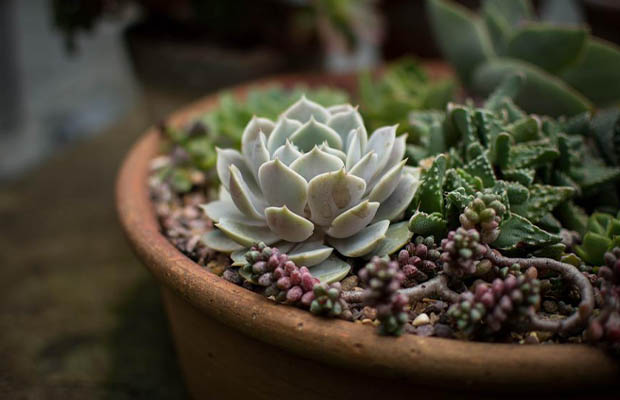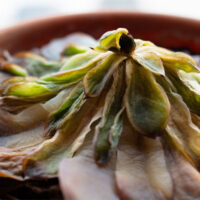When you hear the word “succulent,” what type of plant comes to mind? Due to their relatively low maintenance requirements, succulents are popular plants. They only require a sunny window and not much water or care. But do succulents need a lot of light? In theory, your succulents should get roughly six to eight hours of sunlight a day.
All of your inquiries will be addressed, enabling you to be ready to maintain the happiness and health of your succulent.
Table of Contents
What Is A Succulent?
Succulents are plants that conserve water in their leaves, stems, or both in order to flourish in dry environments or on arid soil. Succulents can be found all over the world, from hot deserts to chilly mountains and tropical rainforests. Cacti, echeveria, aloe, haworthia, hoya, sempervivum, sedum, snake plants, jade plants, and more are popular varieties of succulents.
Related Reading: Do Succulents Need Drainage?
Choose Correct Succulents For Your Home
Any succulent will do if you have a nice, south-facing window or a small grow light. You might be wondering which succulents are suitable for you if your lighting situation is less than ideal. Here are a few succulent varieties that do better than most in low light.
Excellent succulents for low-light areas are snake plants. They have a stunning appearance, require little maintenance, and are challenging to kill. Snake plants are unique in that they can grow healthily in low light conditions and can even tolerate them. Even though they grow more slowly in low light and still prefer direct light, they can be kept in more shaded areas without suffering any negative effects.
Though less common, Gasteria, also known as ox tongue, is the ideal succulent for dimly lit areas. South African native Gasteria grows naturally in light to partial shade. It resembles aloe, another potential low-light succulent, and is more difficult to locate, but the search is worthwhile.
Mistletoe cactus, also known as ripples, is another tough succulent. You don’t need to worry about it because of its remarkable resilience, which makes it stand out in any room thanks to its thin, branching appearance. Rhipsalis thrives in bright, indirect light, making it a great desk plant, but it can endure periods of time in low light. Rhipsalis may be the right succulent for you if you have a location that receives adequate light for the majority of the year but is relatively dark for one or two seasons.
Do Succulents Need A Lot Of Light?
This can vary between different succulent varieties, but as a general rule, your succulents should get roughly six to eight hours of sunlight a day. While succulents that have previously been kept in darker settings will need to be introduced to sunlight gradually in order to prevent burns, most succulents thrive in direct or mostly direct sunlight.
The majority of succulents are not immediately destroyed by shade. Many succulents can actually endure in the shade or with only indirect light for long periods of time. However, succulents grown in inadequate lighting will deteriorate and die. No situation is necessarily healthy for someone just because they can survive it.

Succulent Light Requirements
Species differences in light requirements for succulents result in wide variations. While some succulents, like zz plants and snake plants, can survive in low light settings, others, like cacti and some desert plants, require several hours of bright, direct sunlight each day. For you to figure out how much light your succulent needs, you must first identify the type of succulent you have.
Direct Light
If your plant is receiving direct light through a window, the sun’s rays are hitting it directly. Succulents that need direct light should be placed in front of a south or west-facing window, where they will receive ideally six to seven hours of sunlight each day (although this can vary depending on your variety). There are many succulents that need direct sunlight, such as desert cacti, echeveria, sempervivum, jade, aloe, aeonium, senecio, agave, sedum, and more.
It’s crucial to remember that because it still passes through a window, direct sunlight inside is not as strong as direct sunlight outside. This only really matters if you intend to move your indoor succulents outdoors for any length of time because the sudden change in sun exposure could burn the leaves on your plant. Ensure that you introduce the plants to outdoor direct sunlight gradually by starting with mostly indirect light for a few weeks.
Indirect Light
Before reaching the plant’s leaves, the sun’s rays must pass through a filter, thus creating indirect light. Although the light is indirect, the area is still very bright. Numerous succulent species, including the holiday cacti, snake plants, zz plants, string of hearts, rhipsalis, kalanchoe, and peperomia, flourish in indirect light.
Low Light
Low light is tolerated by a wide variety of succulent species. “This distinction between tolerating and accept is crucial. Although some plants can survive or tolerate lower light levels, most plants thrive in bright, indirect light when grown indoors. You might observe that low-light-grown succulents grow more slowly or have a leggier appearance than those grown in indirect light. Low light typically refers to plants that are placed at least a few feet away from a window and that do not receive bright filtered light or direct sun rays on their leaves. Snake plants, zz plants, kalanchoe, mistletoe cacti, the string of hearts, holiday cacti, fishbone cacti, and other succulents can all withstand low light levels.
Signs Of Light Stress – More Or Less
Succulents will exhibit mild signs of stress when they do not receive enough light. Both too much and too little light can cause light stress.
When given too much light, succulents may start to develop brown crispy edges or spots, or their leaves may start to show signs of discoloration. Low-light succulents and succulents that prefer indirect light to direct light are more susceptible to light stress. Especially if their lighting suddenly undergoes a dramatic change, such as when they are moved from a low-light to a direct-light location.
Stress-related symptoms can also be seen in succulents that don’t get enough light. This is typical of succulents that need a lot of daily direct, bright light, like cacti and succulents from the desert. Watch out for stunted growth, leaf drop, and leggy growth.
Use Grow Lights For Your Succulents
Maintaining the happiness of low-light succulents is typically much simpler than maintaining the happiness of high-light succulents when growing succulents indoors. If your indoor space lacks natural light, using grow lights for succulents that require a lot of direct light is a great way to keep them healthy. Succulents can be grown indoors with full-spectrum LED grow lights, which come in a variety of different price ranges.
Plant-care Tips For Succulents
1. Make Sure Your Succulents Get Enough Light
Depending on the variety, succulents require between six and eight hours of sunlight daily. You might need to gradually expose newly planted succulents to full sun exposure or provide shade with a sheer curtain because they can burn in direct sunlight.
2. Rotate Succulents Frequently
Succulents enjoy direct sunlight, but if yours is always in the same location, it’s likely that only one side of the plant is receiving enough illumination. Ray and Langton recommend frequently rotating the plant. Since succulents tend to lean toward the sun, rotating them will help them stand up straight. (Leaning might also indicate that they require more sunlight.)
3. Water The Soil Directly
Soak the soil around your succulents in water until the drainage holes are full. (Less water should be used if your container lacks drainage holes.) Avoid misting your succulents with a spray bottle as this can lead to brittle roots and moldy leaves. Additionally, you can submerge pots in a pan of water and let the water soak in through the drainage hole. Remove from the pan once the soil’s top has become moist.
4. Water Based On The Season
Just like humans, succulents require more energy during times of growth. The plants require much more water during the spring and summer when they are thriving rather than during the fall and winter when they are dormant. By using a finger to test the soil, Langton and Ray advise that you water the area when the top 1.25 inches are dry. Make sure the soil dries out in between waterings because overwatering can kill your succulent.
5. Keep Succulents Clean
“The inevitable accumulation of dust on your indoor plants’ surfaces can stunt their growth, according to Langton and Ray. Use a soft paintbrush to reach the hard-to-reach areas as you gently wipe the leaves and spines with a damp cloth.
6. Choose A Container With Drainage
Drainage is essential to avoid rot because succulents dislike sitting in waterlogged soil. You need a drainage hole in your container so that extra water can drain out. For beginners, terra-cotta pots are perfect.
7. Get Rid Of Bugs
Succulents kept indoors shouldn’t attract pests, but occasionally you might have to deal with bugs. Planting succulents in soil that is too wet or that lacks proper drainage will attract gnats. Spray the soil with 70% isopropyl alcohol to get rid of eggs and larvae. Owners of succulents must also contend with the pest of mealybugs. Mealybugs are typically brought on by excessive fertilization and irrigation. Remove infected plants from other succulents and spray with 70% isopropyl alcohol.
8. Plant Succulents In The Right Soil
Regular potting soil or dirt from your garden won’t do for succulents because they require soil that drains. Select cactus soil or combine potting soil with sand, pumice, or perlite. When repotting, be gentle because succulent roots are very brittle.
9. Fertilize Succulents In The Summer
Although they don’t require a lot of fertilizer, succulents can benefit from light feedings in the spring and summer when they are actively growing. Be careful not to overfertilize as this can make your succulent grow too quickly and weak.
The Bottom Line
The recommended amount of sunlight for succulents is between four and six hours per day. Plants mature much more slowly indoors because there is less light. Succulents can tolerate low light and shade for a long time, but they won’t thrive there because of their high adaptability. These plants will deteriorate over time, and if they are not given adequate lighting, they might not recover.
I think you now have a thorough understanding of how to plant succulents. Please post your comments below if you have any questions.
















